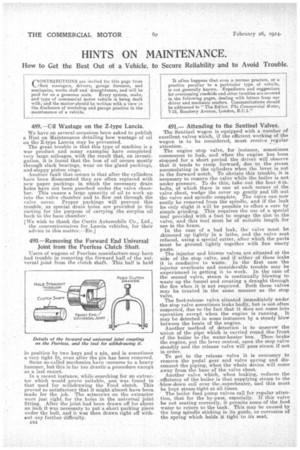HINTS ON MAINTENANCE.
Page 28

If you've noticed an error in this article please click here to report it so we can fix it.
How to Get the Best Out of a Vehicle, to Secure Reliability and to Avoid Trouble.
489.--Oil Wastage on the Z-type Lancia.
We have on several occasions been asked to publish a Hint on Maintenance detailing how wastage of oil on the Z-type Lancia may be prevented. The great trouble is that this type of machine is a war product and many examples have completed very large mileages, with the result that, on investigation, it is found that the loss of oil occurs mostly through slack bearings, wear on the gland packings, and sloppy piston rings. Another fault that occurs is that after the cylinders have been dismounted they are often replaced with new paper packings in which the necessary drain holes have not been punched under the valve chamber. This causes a large quantity of oil to work up into the valve chamber and to flow out through the valve cover. Proper .packings will prevent this trouble, as special drain holes are provided in the casting for the purpose of carrying the surplus oil back to the base chamber
[We wish to thank the Curtis Automobile Co., Ltd., the concessionnaires for Lancia vehicles, for their advice in this matter.—En.]
490.—Removing the Forward Epd Universal Joint from the Peerless Clutch Shaft.
Users of wagons of Peerless manufacture may have had trouble in removing the forward half of the universal joint from the clutch shaft. This half is held in position by two keys and a pin, and is sometimes a very tight fit, even after the pin has been removed. Some so-called mechanics have recourse to a heavy hammer, but this is far too drastic a procedure except as a last resort.
In a recent instance, while searching for an extractor which Would .prove suitable, one was found in that used for withdrawing the Ford clutch. This proved so satisfactory that it might almost have been made for the job. The setscrews on the extractor were just right, for the holes in the universal joint fitting. After the joint had been drawn off for about an inch it was necessary to put a short packing piece under the bolt, and it was then drawn right off withQUi any further difficulty.
c44
491.— Attending to the Sentinel Valves,
The Sentinel wagon is equipped with a number of excellent valves which, if the efficient working of the wagon is to be considered, must receive regular attention.
The engine stop valve, for instance, sometimes commences to leak, and when the engine has been stopped for a short period the driver will observe that it tends to creep forward, due to the steam accumulating in the cylinders when the lever is not in the forward notch. To obviate this trouble, it is necessary to remove the valve while the boiler is not under pressure. To do this, take out the four 6-in. bolts, of which there is one at each corner of the valve chest, wedge the cover up gently and lift out the valve and spindle complete. The valve can now easily be removed from the spindle, and if the leak be only slight it will be possible to effect a cure by simple grinding. This requires the use of a special tool provided with a foot to engage the slat in the valve, and this tool must be of suitable length for use in the brace.
In the case of a bad leak, the valve must be 3kimmed up lightly in a lathe, and the valve seat refaced, using a special cutter, after which the parts must be ground lightly together with fine emery paste.
The injector and blower valves are situated at the side of the stop valve, and if either of these leaks it is. conducive to waste. In the first case the. injector overheats and considerable trouble may be experienced in getting it to work. In thg case of the second valve, steam is continually blowing to waste up the funnel and creating a draught through the fire when it is not required. Both these valves may be treated in the same manner as the stop valve.
The foot-release valve situated immediately under the stop valve sometimes leaks badly, but is not often suspected, due to the fact that it does not come into operation except when the engine is running. It may be detected in some instances by a steady blow between the beats of the engine.
Another method of detection is to unscrew the union of the pipe which is carried round the, front. of the boiler to the water-heater box. Then • brake the engine, put the lever central, open the stop valve steadily and the release valve will pass steam if not in order.
To get to the release valve it is necessary to remove the pedal gear and valve spring and disconnect the piping, when the whole device will come away from the base of the valve chest. Another valve which, when leaking, reduces the efficiency of the boiler is that supplying steam to the -blow-down coil over the.superheater, and this must be kept steam-tight at all times.
The boiler feed pump valves call for regular attention, that for the by-pass, especially. If this valve be not seating correctly, it permits some of the feed water to return to the tank. This may be caused by the long spindle sticking in its guide, or corrosion Of the spring which holds it tight to its seat.






























